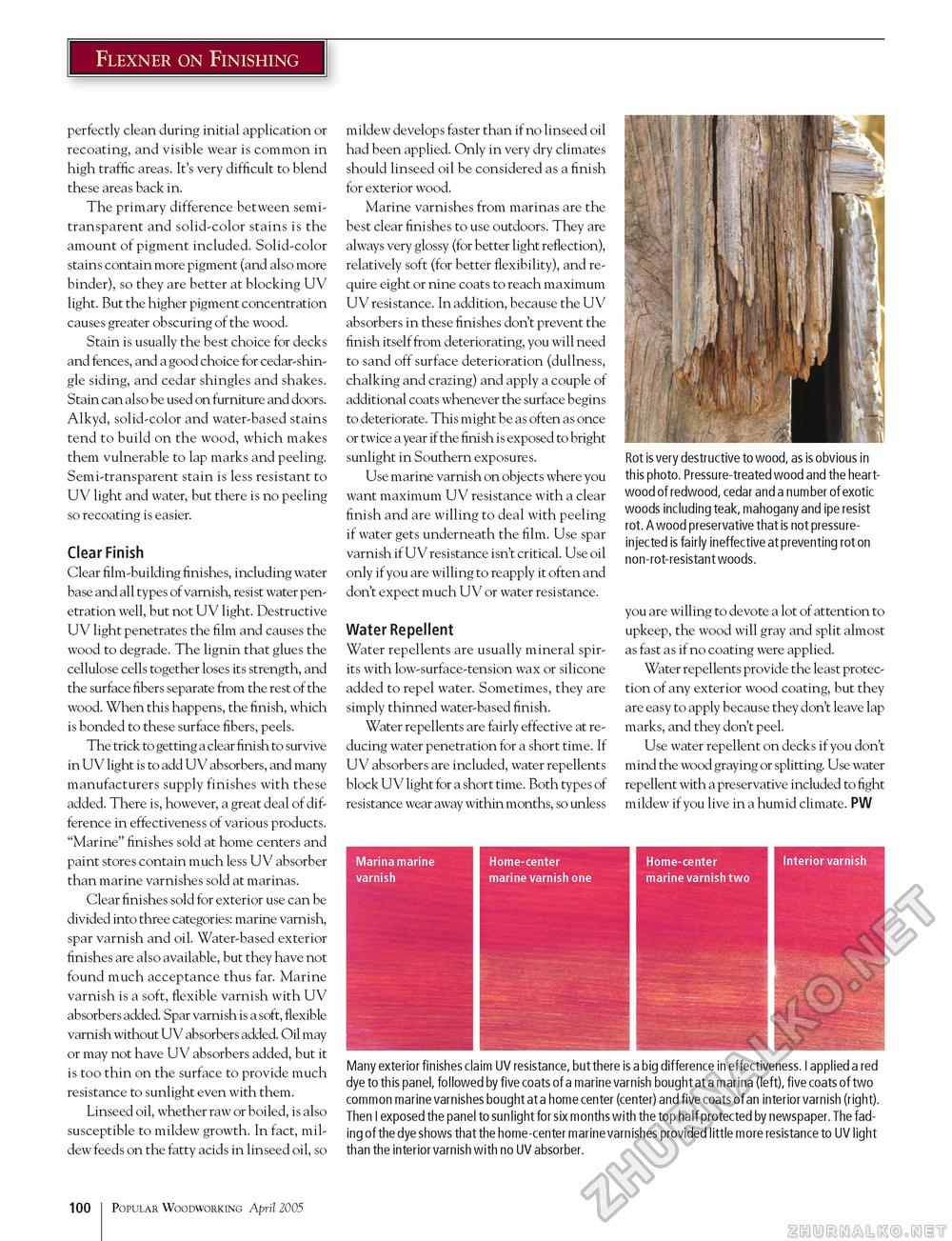Popular Woodworking 2005-04 № 147, страница 104
Flexner on Finishing perfectly clean during initial application or recoating, and visible wear is common in high traffic areas. It's very difficult to blend these areas back in. The primary difference between semi-transparent and solid-color stains is the amount of pigment included. Solid-color stains contain more pigment (and also more binder), so they are better at blocking UV light. But the higher pigment concentration causes greater obscuring of the wood. Stain is usually the best choice for decks and fences, and a good choice for cedar-shingle siding, and cedar shingles and shakes. Stain can also be used on furniture and doors. Alkyd, solid-color and water-based stains tend to build on the wood, which makes them vulnerable to lap marks and peeling. Semi-transparent stain is less resistant to UV light and water, but there is no peeling so recoating is easier. Clear Finish Clear film-building finishes, including water base and all types of varnish, resist water penetration well, but not UV light. Destructive UV light penetrates the film and causes the wood to degrade. The lignin that glues the cellulose cells together loses its strength, and the surface fibers separate from the rest of the wood. When this happens, the finish, which is bonded to these surface fibers, peels. The trick to getting a clear finish to survive in UV light is to add UV absorbers, and many manufacturers supply finishes with these added. There is, however, a great deal of difference in effectiveness of various products. "Marine" finishes sold at home centers and paint stores contain much less UV absorber than marine varnishes sold at marinas. Clear finishes sold for exterior use can be divided into three categories: marine varnish, spar varnish and oil. Water-based exterior finishes are also available, but they have not found much acceptance thus far. Marine varnish is a soft, flexible varnish with UV absorbers added. Spar varnish is a soft, flexible varnish without UV absorbers added. Oil may or may not have UV absorbers added, but it is too thin on the surface to provide much resistance to sunlight even with them. Linseed oil, whether raw or boiled, is also susceptible to mildew growth. In fact, mildew feeds on the fatty acids in linseed oil, so mildew develops faster than if no linseed oil had been applied. Only in very dry climates should linseed oil be considered as a finish for exterior wood. Marine varnishes from marinas are the best clear finishes to use outdoors. They are always very glossy (for better light reflection), relatively soft (for better flexibility), and require eight or nine coats to reach maximum UV resistance. In addition, because the UV absorbers in these finishes don't prevent the finish itself from deteriorating, you will need to sand off surface deterioration (dullness, chalking and crazing) and apply a couple of additional coats whenever the surface begins to deteriorate. This might be as often as once or twice a year if the finish is exposed to bright sunlight in Southern exposures. Use marine varnish on objects where you want maximum UV resistance with a clear finish and are willing to deal with peeling if water gets underneath the film. Use spar varnish if UV resistance isn't critical. Use oil only if you are willing to reapply it often and don't expect much UV or water resistance. Water Repellent Water repellents are usually mineral spirits with low-surface-tension wax or silicone added to repel water. Sometimes, they are simply thinned water-based finish. Water repellents are fairly effective at reducing water penetration for a short time. If UV absorbers are included, water repellents block UV light for a short time. Both types of resistance wear away within months, so unless Rot is very destructive to wood, as is obvious in this photo. Pressure-treated wood and the heart-wood of redwood, cedar and a number of exotic woods including teak, mahogany and ipe resist rot. A wood preservative that is not pressure-injected is fairly ineffective at preventing rot on non-rot-resistant woods. you are willing to devote a lot of attention to upkeep, the wood will gray and split almost as fast as if no coating were applied. Water repellents provide the least protection of any exterior wood coating, but they are easy to apply because they don't leave lap marks, and they don't peel. Use water repellent on decks if you don't mind the wood graying or splitting. Use water repellent with a preservative included to fight mildew if you live in a humid climate. PW Many exterior finishes claim UV resistance, but there is a big difference in effectiveness. I applied a red dye to this panel, followed by five coats of a marine varnish bought at a marina (left), five coats of two common marine varnishes bought at a home center (center) and five coats of an interior varnish (right). Then I exposed the panel to sunlight for six months with the top half protected by newspaper. The fading of the dye shows that the home-center marine varnishes provided little more resistance to UV light than the interior varnish with no UV absorber. 100 Popular Woodworking April 2005 |








